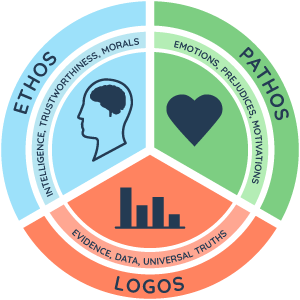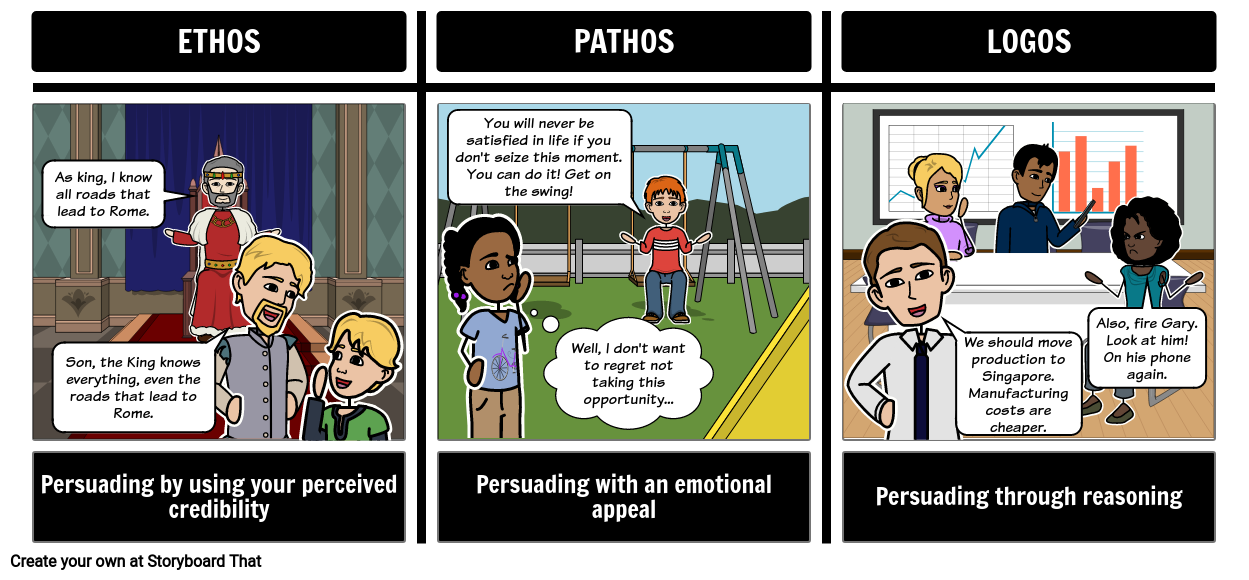In high school, the ELA Common Core State Standards require students to develop formal writing skills, creating essays and arguments that are well-thought-out and syntactically varied. They also require students to effectively use persuasive writing strategies to defend a claim or point of view.
A great way to enhance students' understanding of effective arguments is to teach the Aristotelian concepts of Ethos, Pathos, and Logos. This requires a basic working knowledge of rhetoric. A key to strong persuasive writing is the ability to dissect and validate, or debunk, the rhetoric of other arguments.
The Rhetorical Triangle: Ethos, Pathos, Logos
What is Ethos?
Ethos refers to the credibility of a speaker or writer. It establishes trust and authority on a particular topic. The definition of ethos focuses on character, expertise, reliability, and reputation. When a speaker utilizes ethos, they demonstrate their qualifications, morals, and knowledge to influence an audience.
For example, Martin Luther King Jr.'s "I Have a Dream" speech exemplifies strong ethos. As an influential civil rights activist, MLK established his reputation and character. His credibility compelled audiences nationwide to support the civil rights movement. MLK highlighted his educated background and referred to respected documents like the Constitution to showcase his expertise on racial injustice. This enhanced his ethical appeal.
Ethos appeals to:
- Intelligence
- Virtue
- Morals
- Perception of trustworthiness
What is Pathos?
Pathos evokes emotion in an audience to persuade them. The pathos definition involves appealing to sympathies, imagination, and personal connections. Pathos sways an audience by targeting desires, biases, and motivations. Instead of relying solely on statistics, pathos utilizes vivid language, imagery, and metaphors.
In literature, Charles Dickens leveraged pathos effectively in his novels. For example, Oliver Twist depicts the appalling conditions of orphanages and child labor. Dickens magnified feelings of outrage and empathy through emotive descriptions of Oliver's miserable circumstances. This made the public determined to correct social injustices impacting children.
Pathos appeals to:
- Emotions and feelings
- Biases and prejudices
- Senses
- Motivations
What is Logos?
Logos utilizes facts, data, and logical reasoning to construct a persuasive argument. The logos definition focuses on credibility rooted in rationality rather than emotion. Logos establishes an argument as logical and sound through citing evidence, testimonies, and statistics, and providing context. Unlike pathos, logos avoids sentimentality in favor of objective explanations.
For instance, a scientific paper delivers logos by presenting methodical research and empirical evidence. The paper avoids unverified assumptions or subjective viewpoints. Through precise language and factual details, the author systematically supports their hypothesis with logical analysis of experiments and results. This logos strengthens the paper's central thesis.
Logos utilizes:
- Evidence
- Testimony
- Statistics and Data
- Universal truths
Rhetorical Strategies and Devices
The successful implementation of ethos, pathos, and logos in writing or speech depends on the effectiveness of different rhetorical strategies. There are many different rhetorical strategies (and rhetorical fallacies!) that can strengthen or weaken an argument. A few of the more familiar strategies to students include:
| Rhetorical Questions | encourages audience to think about an obvious answer |
| Analogy | establishes a more familiar concept to explain a more complicated or remote subject |
| Rebuttal | disproves or refuses an assertion |
| Antithesis | uses strongly contrasting words, images, or ideas |
| Parallelism | repeats a grammatical structure to emphasize an important idea |
| Repetition | repeats a specific word or phrase to ensure that the audience pays attention |
| Loaded Words | uses the connotations of words to play on the audience’s emotions |
| Restatement | expresses the same idea but in different words to clarify or emphasize |
| Understatement or Overstatement | use to be ironic, call attention to an idea, or to emphasize an idea through exaggeration |
Rhetorical Strategies in Action
By recognizing the tactics of a persuasive argument, students learn to use it themselves and recognize these tactics in daily life. One excellent way to teach and review the concepts of ethos, pathos, and pathos is through a storyboard.
In the following example storyboard, each concept is briefly explained and then shown in action. When students create a definition or example board like this, classroom concepts are reinforced, and students have the chance to demonstrate them creatively.
By incorporating the visual elements of a storyboard as well as text, even students who struggle creating organized written thoughts can demonstrate mastery of the subject. Additionally, teachers can immediately see and respond to inaccuracies, allowing them to use class time to assess and correct, rather than handing back graded work a day or two later.
Using Storyboards In Your Classroom
- Use storyboards to create advertisements for products using Ethos, Pathos, or Logos to convince potential buyers.
- Use a storyboard to create an “argument diagram” of a famous speech. Students can break the speech up into tactics, then show an example of those tactics in each cell.
- Ask students to create a persuasive storyboard about a topic that is important to them. Require them to use one, or all, of the tactics in the rhetorical triangle.
- Have students collaborate and promote an unpopular school rule, consequence, homework, or even cafeteria food. Have them utilize rhetorical tactics and strategies in their promotion. Having to flip a negative idea into a positive one is also a great way to teach propaganda.
- Give students an empty storyboard as part of an assessment and ask them to explain and give an example of each: ethos, pathos, logos.
Engaging Activities for Teaching Ethos, Pathos, and Logos
Check out these ethos, pathos, logos activities from our guides on Narrative of the Life of Frederick Douglass, The Tragedy of Julius Caesar, and "Letter from Birmingham Jail".
| Proficient 33 Points | Emerging 25 Points | Beginning 17 Points | |
|---|---|---|---|
| Ethos, Pathos, and Logos | The elements of ethos, pathos, and logos are correctly identified and depicted, and an appropriate quote or summary is provided. There are at least 2 examples provided for each rhetorical element. | Most of the elements of ethos, pathos, and logos are correctly identified and depicted, and an appropriate quote or summary is provided. There are at least 2 examples provided for each rhetorical element. | The elements of ethos, pathos, and logos are incorrectly identified and depicted. Quotes and summaries may be missing or too limited. Only one example may have been provided for each rhetorical element. |
| Artistic Depictions | The art chosen to depict the scenes are accurate to the work of literature. Time and care is taken to ensure that the scenes are neat, eye-catching, and creative. | The art chosen to depict the scenes should be accurate, but there may be some liberties taken that distract from the assignment. Scene constructions are neat, and meet basic expectations. | The art chosen to depict the scenes is inappropriate. Scene constructions are messy and may create some confusion, or may be too limited. |
| English Conventions | Ideas are organized. There are few or no grammatical, mechanical, or spelling errors. | Ideas are mostly organized. There are some grammatical, mechanical, or spelling errors. | Ideas may be disorganized or misplaced. Lack of control over grammar, mechanics, and spelling reflect a lack of proofreading. |
How to Create a Persuasive Advertisement Using Ethos, Pathos, and Logos
Create a fictional product or cause as a class.
Choose something silly or fun—like “Homework-B-Gone Gum” or “Bring Back Recess” to spark engagement and creativity.
Assign each appeal to a separate frame.
Have students plan one cell for ethos (credibility), one for pathos (emotion), and one for logos (logic). This ensures they think critically about how each method persuades.
Brainstorm persuasive techniques.
Guide students to use specific strategies like expert endorsements for ethos, emotional imagery for pathos, and data or facts for logos.
Design the storyboard.
Students use visuals and captions to show how each appeal would convince someone to buy their product or support their cause.
Present and explain.
Students share their ad and identify which rhetorical strategy is used in each panel, explaining why it was effective.
Display the ads around the classroom.
Create a "Persuasion Gallery Walk" to let students view each other’s work and discuss which appeals stood out and why.
Frequently Asked Questions about Ethos, Pathos, and Logos
What is the difference between ethos, pathos, and logos?
Ethos appeals to credibility or character, pathos appeals to emotions, and logos appeals to logic and reason. Together, they form the rhetorical triangle used to persuade an audience.
How do I teach ethos, pathos, and logos to middle school students?
Start with real-world examples like commercials or speeches, define each appeal, and then guide students through identifying them. Visual tools like storyboards or graphic organizers can make abstract concepts more concrete.
What are some examples of ethos, pathos, and logos in real life?
Ethos appears when a doctor gives medical advice, pathos is used in animal shelter ads to evoke sympathy, and logos is common in statistics-based commercials or news reports.
What’s the best way to explain the rhetorical triangle to students?
Describe it as a persuasive triangle: ethos builds trust, pathos makes people feel, and logos makes people think. Draw it visually and show how great arguments use a mix of all three.
Why is it important for students to understand ethos, pathos, and logos?
Understanding these appeals helps students think critically about arguments, become better writers, and recognize persuasion in media and everyday life.
How can I use storyboards to teach persuasive appeals?
Storyboards allow students to visually map out a persuasive argument and label where ethos, pathos, and logos are being used. This helps reinforce concepts while boosting creativity.
What are common rhetorical strategies students should know?
In addition to the rhetorical triangle, teach repetition, rhetorical questions, parallelism, and analogies to help students analyze and craft stronger arguments.
What’s an easy activity to help students practice rhetorical appeals?
Have students create a three-frame storyboard advertisement using each appeal—ethos, pathos, and logos—to promote a made-up product or cause.
© 2025 - Clever Prototypes, LLC - All rights reserved.
StoryboardThat is a trademark of Clever Prototypes, LLC, and Registered in U.S. Patent and Trademark Office








